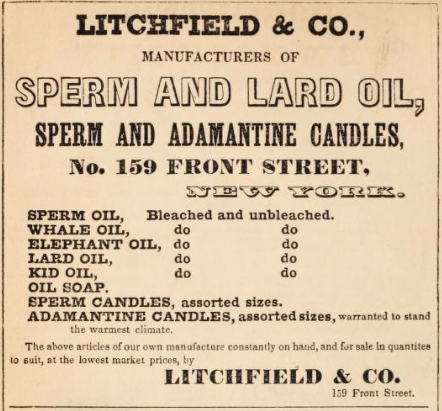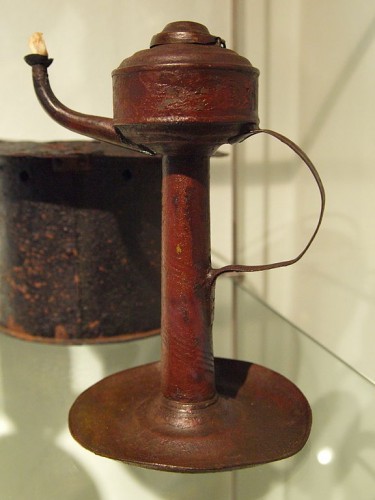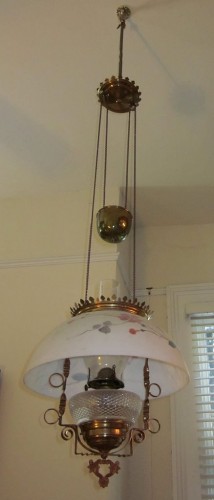Shopping Saturday: Springsteens Keeping the Lights On in 1845

Springsteen Family (Click for Family Tree)
Twenty years ago, keeping the lights on was as simple as flipping a switch, and our shopping Saturday dilemma was whether to get soft white or bright white lightbulbs, and which wattage. Today it is more complicated, with rows of incandescent, halogen, LED, Edison, and other types of lightbulbs lining store shelves, with a myriad variety of bases. (More technology= simpler lifestyle??)
Keeping the lights on was complicated for our ancestors, too. Jefferson and Anna Connor Springsteen, living in Brooklyn, NY in 1845, did not have the luxury of flipping a switch, but had to deal with oil for lamps and candles, as well as wood for stoves/fireplaces which would also provide a little light. No wonder families tended to get up at dawn and go to bed when it got dark- you could save a lot of money by buying less oil and candles! For those on the frontier, where goods and stores were scarce, making their own or doing without was the only way they could survive.
Oil lamps have been used since ancient times, with a variety of oils used as fuel. Candles have been made from a variety of substances throughout the years as well. Beeswax candles are considered to be the very best, however they are also very expensive since bees make such a small amount of wax for each hive- they could never keep up with the booming American economy that was ten times as large in 1860 as it had been in 1800. In 1858, kerosene began to take the place of animal-based oils in lamps, and paraffin began to be used for candles. Paraffin was inexpensive, burned cleanly and without odor, but melted easily. Once stearin was discovered, it was added to candles and raised the melting point, so they would not soften in hot weather or warm buildings.

Sperm Oil and Candles
Living in the northeast in a port city and so close to the ocean, the Springsteens would have had easy access to oil from whales. Whaling provided a lot of products in the early 1800s, including oil, which was used for lamps, making candles, as a lubricant for machinery including the booming railroads’ rolling stock; locomotive headlights used whale oil too. Sperm whale oil was used for light, fast-moving machinery, such as that in the cotton mills. Heavier whale oil, derived from a number of species, would be used in the heavy machinery like locomotive engines.
Whalers would boil the blubber from a whale to create oil, put it in casks and it would be sold around the country for lubricants and illumination, as well as for use in the manufacture of soaps, varnish, and paints. Spermaceti, a waxy oil from the head of the whale (it was used for buoyancy and echolocation by the whale), was the most valuable of the whale oils. Over 500 gallons of spermaceti oil could be harvested from just one sperm whale. Because of its waxy properties, it made what was considered the finest candle, which had a very bright and clear flame, good for reading, and these candles did not emit a lot of smoke. Spermaceti oil also was used as a lubricant in precision machinery- thus some say that whaling is what drove the success of American industry in the 1800s.
Sperm oil would make brown candles if used naturally, but was often bleached to make a pure white candle- more elegant but of course more expensive. Around 1800, sperm candles cost three times the price of tallow candles. Tallow candles were made of the fat of sheep and cattle, and were made at home by many families. They burned unevenly, their light was not as bright as sperm candles, and in hot weather, tallow candles would collapse once they softened. Tallow candles also had a very unpleasant odor when burned. Tallow could be used as a lubricant, as well.
Lard Oil
In the 1800s, the American diet consisted of a very high proportion of meats. This meant that there was an abundant supply of lard from slaughterhouses. Lard, while used in pie crusts and other edible goods, was also made into lamp oil. It was inexpensive because it was an animal byproduct, but the quality was poor. It required a higher temperature for burning and didn’t flow well as the fats tended to congeal in a lamp, especially when ambient temperatures were low.

Adamantine Candles
Stearic acid, derived from animal fats, was added to wax to make adamantine candles. The stearic acid hardened the candle, making them less apt to melt in hot weather.
Elephant Oil
Likely ‘sea elephants’ or elephant seal oil. These large animals found on the Pacific coast were also used for lamp oil in the 1800s. A large bull could yield 210 gallons of oil made from their blubber, and these animals were hunted to what was thought was extinction. Eight individuals were found in 1892 when the Smithsonian expedition killed seven of them for their collection; amazingly the population survived and due to legal protection, colonies now thrive.
!["Breeding colony of Mirounga angustirostris"[elephant seals] by Brocken Inaglory - Own work. Licensed under GFDL via Commons - https://commons.wikimedia.org/wiki/File:Breeding_colony_of_Mirounga_angustirostris.jpg#/media/File:Breeding_colony_of_Mirounga_angustirostris.jpg](http://heritageramblings.net/wp-content/uploads/2015/08/640px-Breeding_colony_of_Mirounga_angustirostris-500x334.jpg)
Possibly from young goats? No information found on this oil.
Oil Soap
A candle-maker was called a “chandler.” Chandlers used raw products such as whale oil and tallow to produce a variety of products, from candles and oils to soaps, sauces, paints, and varnishes.
Notes, Sources, and References:
1) A variety of websites were sources of information in this article:
http://history1800s.about.com/od/whaling/f/whaleproducts01.htm
In Pursuit of Leviathan: Technology, Institutions, Productivity, and Profits …
By Lance E. Davis, Robert E. Gallman, Karin Gleite
https://en.wikipedia.org/wiki/History_of_candle_making
https://en.wikipedia.org/wiki/Kerosene_lamp
https://historyweaver.wordpress.com/2009/07/16/lighting-the-way/
https://en.wikipedia.org/wiki/Spermaceti
Please contact us if you would like higher resolution images. Click to enlarge images.
We would love to read your thoughts and comments about this post (see form below), and thank you for your time! All comments are moderated, however, due to the high intelligence and persistence of spammers/hackers who really should be putting their smarts to use for the public good instead of spamming our little blog.